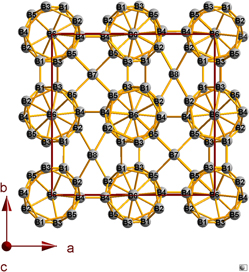Crossref Citations
This article has been cited by the following publications. This list is generated based on data provided by
Crossref.
Shirai, Koun
2017.
Phase diagram of boron crystals.
Japanese Journal of Applied Physics,
Vol. 56,
Issue. 5S3,
p.
05FA06.
Shirai, Koun
Uemura, Naoki
and
Dekura, Haruhiko
2017.
Structure and stability of pseudo-cubic tetragonal boron.
Japanese Journal of Applied Physics,
Vol. 56,
Issue. 5S3,
p.
05FB05.
Podryabinkin, Evgeny V.
Tikhonov, Evgeny V.
Shapeev, Alexander V.
and
Oganov, Artem R.
2019.
Accelerating crystal structure prediction by machine-learning interatomic potentials with active learning.
Physical Review B,
Vol. 99,
Issue. 6,
Uemura, Naoki
Shirai, Koun
Kunstmann, Jens
Ekimov, Evgeny A
and
Lebed, Yuliya B
2019.
Hydrogenation, dehydrogenation of α-tetragonal boron and its transition to δ-orthorhombic boron.
Journal of Physics: Materials,
Vol. 2,
Issue. 4,
p.
045004.
He, Xin-Ling
Shao, Xi
Chen, Tong
Tai, Yu-Ke
Weng, Xiao-Ji
Chen, Qun
Dong, Xiao
Gao, Guoying
Sun, Jian
Zhou, Xiang-Feng
Tian, Yongjun
and
Wang, Hui-Tian
2019.
Predicting three-dimensional icosahedron-based boron
B60.
Physical Review B,
Vol. 99,
Issue. 18,
Hayami, Wataru
and
Tanaka, Takaho
2020.
Superconductivity of alkali-metal intercalated BC2.
AIP Advances,
Vol. 10,
Issue. 6,
Eisele, Claudio
Hübschle, Christian B.
Mondal, Swastik
Dey, Somnath
van Smaalen, Sander
and
Paulmann, Carsten
2020.
Boranes: The Boron Subhydride B104.67H3 with a Distorted β-Boron Crystal Structure.
Inorganic Chemistry,
Vol. 59,
Issue. 18,
p.
13295.
Shirai, K.
and
Kimura, K.
2021.
Li doping to boron at high pressures.
Solid State Sciences,
Vol. 112,
Issue. ,
p.
106459.
Zhang, Haibo
Shen, Yidi
Lahkar, Simanta
Fujita, Takeshi
Hemker, Kevin
An, Qi
and
Reddy, Kolan Madhav
2021.
Distorted planar defects stabilize tetragonal boron.
Scripta Materialia,
Vol. 194,
Issue. ,
p.
113685.
Zhang, Haibo
Örnek, Metin
Lahkar, Simanta
Song, Shuangxi
Wang, Xiaodong
Haber, Richard A.
and
Reddy, Kolan Madhav
2022.
Enhanced densification and mechanical properties of β-boron by in-situ formed boron-rich oxide.
Journal of Materials Science & Technology,
Vol. 99,
Issue. ,
p.
148.
Yu, Chia-Chi
Ormeci, Alim
Veremchuk, Igor
Feng, Xian-Juan
Prots, Yurii
Krnel, Mitja
Koželj, Primož
Schmidt, Marcus
Burkhardt, Ulrich
Böhme, Bodo
Akselrud, Lev
Baitinger, Michael
and
Grin, Yuri
2023.
Na2Ga7: A Zintl–Wade Phase Related to “α-Tetragonal Boron”.
Inorganic Chemistry,
Vol. 62,
Issue. 23,
p.
9054.
Pancharatna, Pattath D.
Dar, Sohail H.
and
Balakrishnarajan, Musiri M.
2023.
Comprehensive Inorganic Chemistry III.
p.
26.
Hayami, Wataru
Hiroto, Takanobu
Soga, Kohei
Ogitsu, Tadashi
and
Kimura, Kaoru
2024.
Thermodynamic stability of elemental boron allotropes with varying numbers of interstitial atoms.
Journal of Solid State Chemistry,
Vol. 329,
Issue. ,
p.
124407.
Huang, Ming-Xing
Fan, Changzeng
Xu, Bo
Hou, Jingyu
Shao, Xi
Weng, Xiao-Ji
Zhang, Xiang
Hu, Wentao
Gao, Yufei
Wang, Lin
Zhao, Zhisheng
Yang, Guochun
Zhang, Dongzhou
Wang, Yanbin
Liu, Zhongyuan
Zhou, Xiang-Feng
and
Tian, Yongjun
2024.
Hard Copper Boride with Exceptional Conductivity.
Physical Review Letters,
Vol. 133,
Issue. 13,




